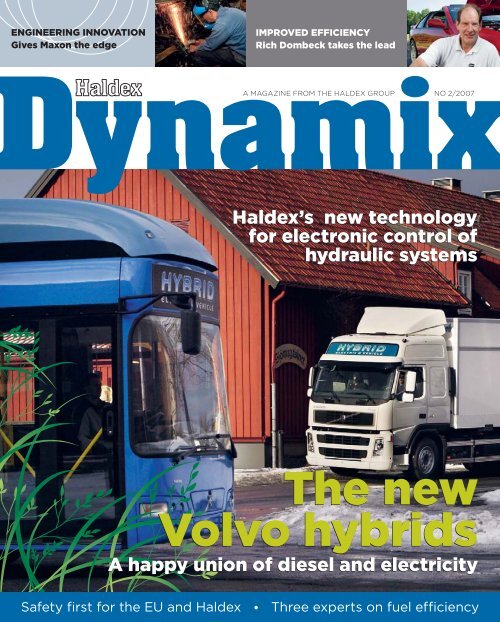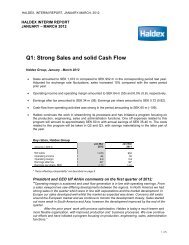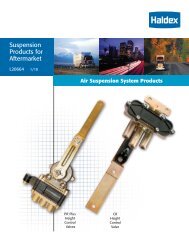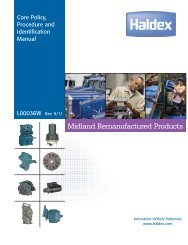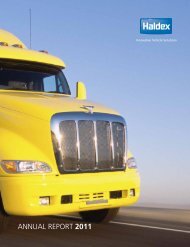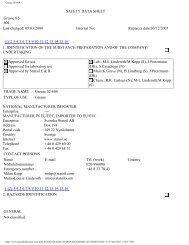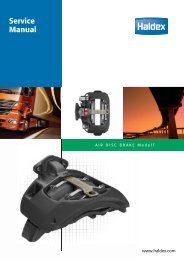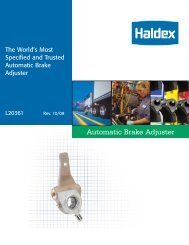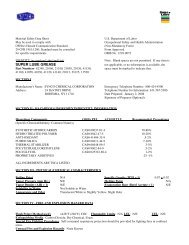Innovation ´ the environment¸s best friend - Haldex
Innovation ´ the environment¸s best friend - Haldex
Innovation ´ the environment¸s best friend - Haldex
Create successful ePaper yourself
Turn your PDF publications into a flip-book with our unique Google optimized e-Paper software.
����������������������<br />
��������������������<br />
��������������������<br />
���������������������������<br />
������������������������������������������������������������<br />
�������������������������<br />
�������������������������<br />
��������������������������<br />
��������������������������<br />
�����������������<br />
�����������������<br />
�������� ��������<br />
�������������<br />
�������������<br />
���������������������������������������<br />
���������������������������������������<br />
�������������������������������������������������������������������������
�Content<br />
News<br />
��������������������������������������������<br />
�����������������������������������������������<br />
���������������<br />
Customer first<br />
������������������������������������������<br />
����������������������������<br />
<strong>Haldex</strong> people<br />
���������������������������������������<br />
����������������������������������������<br />
�����������������������������������������<br />
�������������������������<br />
��<br />
Expertise<br />
�����������������������������������������������<br />
����������������������������������������������������<br />
������������������������������<br />
�����������������������������������������<br />
�������������������������������������������������<br />
��������������������������<br />
��������������������������������������������<br />
���������������������������������������������<br />
Features & Friends<br />
���������������������������������������������<br />
�����������������������������������������������<br />
�������������������������������������������������<br />
�����������������������������������<br />
�����������������������������������������������<br />
�����������������������������������<br />
��<br />
����������������������������������������������������������������������������������������������������������������������<br />
���������������������������������������������������������������������������������������������������������������������������������������������������<br />
������������������������������������������������������������������������������������������������������������������������������������������������<br />
���������������������������������������������������������������������������������������������������������������������������������<br />
�������������������������������������������������������������������������������������������������������������������������������������������<br />
�����������������������<br />
�����������������������������������<br />
��������������������������������������<br />
�����������������������������������<br />
��<br />
��������������
��������������<br />
�<br />
�������������������������������������������������������������������<br />
���������������������������������������������������������������������<br />
��������������������������������������<br />
�����������������<br />
�������������������������<br />
����������������� concept is to provide innovative technology<br />
solutions that improve safety, <strong>the</strong> environment and vehicle dynamics<br />
to <strong>the</strong> global vehicle industry. In this issue of Dynamix, we have chosen<br />
to explore <strong>the</strong> topic of <strong>the</strong> environment. Regardless of different<br />
opinions on this complex area, <strong>the</strong>re is no doubt that environmental<br />
issues are <strong>the</strong> most important facing <strong>the</strong> world today. In an effort to<br />
solve <strong>the</strong>se issues, great expectations are placed on <strong>the</strong> international<br />
vehicle industry. At <strong>Haldex</strong>, we take <strong>the</strong> responsibility of providing our<br />
customers – and, in turn, <strong>the</strong>ir customers – with technology and solutions<br />
for sustainable environmental development very seriously.<br />
However, I would like to begin by mentioning a current and highly<br />
successful example of <strong>Haldex</strong>’s focus on safety. This past summer, <strong>the</strong><br />
sparc project, an eu-initiated traffic safety project that involved leading<br />
players in <strong>the</strong> vehicle industry, reached its conclusion. <strong>Haldex</strong>’s contribution<br />
to <strong>the</strong> project was an excellent example of our emphasis on innovative<br />
products and solutions. In this case, we developed a brake system<br />
with Electro Mechanical Brakes (emb) for a combined truck and trailer.<br />
Last winter, I was in Arjeplog in nor<strong>the</strong>rn Sweden and had <strong>the</strong><br />
opportunity to test drive a truck that was equipped with this new brake<br />
system. I drove <strong>the</strong> truck on a frozen lake with low friction conditions,<br />
which offered a fantastic experience of shortened braking distances.<br />
While <strong>the</strong> 20-ton truck previously required 120 meters of braking distance,<br />
<strong>the</strong> new system offered a braking distance of 90 meters – in o<strong>the</strong>r<br />
words, a remarkable difference on an incredibly difficult surface.<br />
Back to <strong>the</strong> environment. <strong>Haldex</strong> works actively to assume our environmental<br />
responsibility and develop <strong>the</strong> commercial opportunities<br />
offered by <strong>the</strong> environmental field. In several of our markets, environmental<br />
legislation is becoming more stringent, including limits for<br />
engine emissions. This has resulted in an increased demand for Alfdex,<br />
<strong>the</strong> highly successful crankcase gas cleaning system developed by <strong>Haldex</strong><br />
in close cooperation with Alfa Laval.<br />
The vehicle industry has shown considerable interest in our new<br />
technology Varivent, an adjustable pump that recirculates exhaust gases<br />
in diesel engines and thus reduces emissions of harmful gases. Varivent<br />
is presently in an evaluation stage and undergoing customer testing,<br />
but <strong>the</strong> results look highly promising.<br />
<strong>Haldex</strong>’s solutions for exhaust gas recirculation (egr) are highly<br />
sought-after in <strong>the</strong> us, but are also used by such European companies<br />
as Scania and man. egr recirculates 30% of exhaust gases and reduces<br />
emissions by more than 80%.<br />
Fur<strong>the</strong>r on in <strong>the</strong> magazine, ano<strong>the</strong>r future product is presented<br />
– Energy Management Systems (ems). For vehicles that brake frequently,<br />
ems can help reduce fuel consumption substantially. The<br />
environment is without a doubt <strong>the</strong> key issue facing<br />
<strong>the</strong> vehicle industry today. <strong>Haldex</strong> is eager to contribute<br />
actively to long-term sustainable development<br />
for <strong>the</strong> environment through leading<br />
competence, technology and innovation.<br />
Joakim Olsson<br />
Managing Director<br />
and Group ceo<br />
�����������������������
�News<br />
�����������������������<br />
��������������������������������������������������������<br />
��������������������������������������������������������������<br />
���������������������������������������������������������������<br />
��������������������������������������������������������<br />
����������������������������������������������������������<br />
��������������������������������������������������������<br />
���������������������������������������������������������������<br />
����������������������������������������������������������������<br />
�������������������������������������������������������������<br />
�������������������������������������������������������������<br />
�������������������������������������������������������������<br />
��������������������������������������������������������������<br />
������������������������������������������������������������<br />
��������������������������������������������������������<br />
�����������<br />
�����������������������������������������������������<br />
����������������������������������������������������������<br />
���������������������������������������������������������<br />
�������������������������������������������������������������<br />
��������� �����������������<br />
����������������� ��������������<br />
�����������������������<br />
�������������������������������������������<br />
�������������������������������������<br />
��������������������������������������������<br />
�������������������������������������������������<br />
����������������������������������������<br />
����������������������<br />
����������������� pumping 938 million gallons of fuel more annually<br />
than <strong>the</strong>y were in 1960 as a result of extra weight in vehicles. And when gas<br />
prices average $3 a gallon, <strong>the</strong> tab for overweight people in a vehicle amounts to<br />
$7.7 million a day, or $2.8 billion a year.<br />
The numbers are added costs linked directly to <strong>the</strong> extra drain of<br />
body weight on fuel economy. In a paper published in <strong>the</strong> journal The<br />
Engineering Economist, <strong>the</strong> scientists conclude that each extra pound<br />
of body weight in all of today’s vehicles results in <strong>the</strong> need for more<br />
than 39 million gallons of extra gasoline usage each year.<br />
“The reason we looked at this issue was that gas prices hit an<br />
average exceeding $3 per gallon in September 2005,” said Sheldon<br />
H. Jacobson, director of <strong>the</strong> simulation and optimization<br />
laboratory at Illinois.<br />
In light of <strong>the</strong> fact that Europe’s waistlines also have expanded<br />
in <strong>the</strong> last decades, this source of increased fuel consumption<br />
can easily be applied to a number of countries.<br />
��������������
�����������������<br />
������������������������������<br />
�����������������������<br />
�����������������������������������with an<br />
electronic awd-system, based on <strong>the</strong> fourth generation of<br />
its established <strong>Haldex</strong> Limited Slip Coupling and <strong>the</strong> all<br />
new, evolutionary <strong>Haldex</strong> electronic Limited Slip Differential<br />
(<strong>Haldex</strong> xwd) developed from <strong>the</strong> <strong>Haldex</strong><br />
product platform of limited slip<br />
differentials. The system will be a<br />
feature of <strong>the</strong> new saab 9-3.<br />
Employed in conjunction<br />
with <strong>the</strong> <strong>Haldex</strong> coupling, <strong>the</strong><br />
electronically controlled addon<br />
module integrates in <strong>the</strong><br />
power and control systems<br />
of <strong>the</strong> longitudinal device<br />
thus offering a fl exible and<br />
cost effective solution for fur<strong>the</strong>r<br />
enhanced vehicle dynamics.<br />
It can be optionally used<br />
in <strong>the</strong> vehicle product lines to<br />
control <strong>the</strong> side-to-side torque<br />
distribution and constitutes an effi cient<br />
alternative relative brake based systems which dissipate<br />
power for control. The limited weight and size maximizes<br />
performance with minimal impact on fuel economy.<br />
The <strong>Haldex</strong> coupling and <strong>Haldex</strong> xwd will be manufactured<br />
and supplied from a new <strong>Haldex</strong> production facility<br />
in Irapuato, Mexico.<br />
��������������<br />
�����������������<br />
�������������������������<br />
�����������������������<br />
�����������������������<br />
�������������������������<br />
�����������������������<br />
��������������������������<br />
���������������������������������������������������������<br />
�����������������������������������������������������<br />
�����������������������������������������������������<br />
������������������������������������������������������<br />
���������������������������������������������������������<br />
�����<br />
��������������<br />
<strong>Haldex</strong> currently supply three of <strong>the</strong> major oem groups,<br />
vw, Ford Motor Company and General Motors with proprietary<br />
and advanced systems and solutions for awd.<br />
����������������������������������������������������<br />
www.haldex-traction.com/xwd<br />
�����������������<br />
�������������������<br />
������������������������������������������������<br />
����������������������������������������������������<br />
��������������������������������������������������<br />
������������������������������������������������<br />
����������������������������������������������������<br />
������������������������������������������������������<br />
����������������������<br />
�������������������������������������������<br />
��������������������������������������������������<br />
������������������������������������������������<br />
�������������������������������������������������������<br />
�������������������������������������������������<br />
��������������������������������������������������<br />
�������������������������������������������������<br />
��������������������������������������������������<br />
�������������������<br />
�����������������������
���������<br />
�����������������������������������<br />
A yellow and black nameplate marks <strong>the</strong> presence of one <strong>the</strong> Maxon’s<br />
liftgates, ubiquitous on trucks worldwide. Maxon has been <strong>the</strong> leader in<br />
<strong>the</strong> liftgate industry for 50 years, in part because <strong>the</strong> company goes out<br />
of its way to provide solutions to customers’ problems.<br />
���������������������������������<br />
In 1957, just two years after <strong>the</strong> world famous Disneyland<br />
amusement park opened in Anaheim, California,<br />
ano<strong>the</strong>r iconic name was born 10 miles up <strong>the</strong> road.<br />
Maxon Lift Corporation was <strong>the</strong> brainchild of Max<br />
trailer bed down to <strong>the</strong> ground. Originally cranked with<br />
muscle power, most lifts now use sophisticated hydraulic<br />
systems to move <strong>the</strong> platform. This year marks Maxon’s<br />
50th anniversary, and <strong>the</strong> company continues to dominate<br />
Lugash, who developed <strong>the</strong> world’s first liftgate to fold up <strong>the</strong> liftgate market, producing a wide variety of liftgates for<br />
under a truck body. This innovative liftgate is known as <strong>the</strong> smaller pickups up to <strong>the</strong> largest trailers.<br />
�������������������������� Tuk-A-Way, and it is still <strong>the</strong> most popular and <strong>best</strong>-sell- Today Maxon remains a family company, as are <strong>the</strong><br />
�����������������������<br />
��������������������������<br />
������������������<br />
ing liftgate in <strong>the</strong> world. Designed to fasten at <strong>the</strong> rear of<br />
a truck or trailer, it smoothly lowers a platform from <strong>the</strong><br />
majority of companies in this industry. It is based in Santa<br />
Fe Springs, in sunny sou<strong>the</strong>rn California, and <strong>the</strong> road<br />
leading to its headquarters has tall, stately palm trees lining<br />
<strong>the</strong> center boulevard. Maxon is now headed by a third generation<br />
of <strong>the</strong> family and is <strong>the</strong> largest privately held manufacturer<br />
of liftgates in <strong>the</strong> world. The company employs<br />
about 500 people worldwide, and its customer base<br />
includes leasing and truck rental companies, overnight<br />
delivery fleets and <strong>the</strong> country’s largest corporate trucking<br />
fleets. Maxon’s yellow and black nameplate can be found<br />
rolling down just about any street in <strong>the</strong> United States.<br />
Always an innovator, Maxon brought <strong>the</strong> rail style liftgate<br />
to <strong>the</strong> u.s. in <strong>the</strong> 1970s and now produces many specialized<br />
liftgates to handle unique cargo or to fit one-of-a-kind<br />
trucks. Its top of <strong>the</strong> line, and one of <strong>the</strong> most sophisticated<br />
liftgates in existence, is <strong>the</strong> Columnlift, <strong>the</strong> bmr series that<br />
this year has begun using a <strong>Haldex</strong> self-contained power<br />
unit. Available with ei<strong>the</strong>r a steel or an aluminum platform<br />
and made to handle up to 6,600 pounds of cargo, <strong>the</strong><br />
Columnlift features a long list of improvements that have<br />
made it one of Maxon’s <strong>best</strong>-selling lifts.<br />
Maxon stays in <strong>the</strong> lead in this industry by focusing on<br />
engineering innovation, often driven by customer requests.<br />
�<br />
The company even has a special order request team that<br />
����������������������� ��������������
You’re amazed on a day-to-day basis<br />
how much passion, heart and soul you<br />
find in our people for this product.<br />
Anton Griesner<br />
�������������� �����������������������
develops unique solutions for customers. Joe Aguilera is<br />
<strong>the</strong> Maxon purchasing manager. He explains how <strong>the</strong> company<br />
developed cart stops to solve an annoying problem for<br />
some customers. “There are customers, like in <strong>the</strong> bakery<br />
industry or pizza delivery business, where <strong>the</strong>y have very<br />
light carts with a propensity for rolling out, and we provided<br />
a custom solution to that problem,” he says.<br />
Engineering support and research and development are<br />
keys to staying ahead in this very competitive business says<br />
Sherry Lafferty, Maxon’s engineering manager in its Santa<br />
Fe Springs Tech Center. She cites improvements such as<br />
bearings that are manufactured for low maintenance and<br />
without need for grease and platforms made with aluminum<br />
extrusions for added strength and less weight. “We’ve<br />
changed spring sizes, added torsion bars, changed design<br />
in opener arms,” explains Aguilera. “We’re constantly opti-<br />
We have very novice users to<br />
very sophisticated users … so we have<br />
to make it very user <strong>friend</strong>ly so someone<br />
who has no experience with <strong>the</strong><br />
gate will be able to operate it properly.<br />
Joe Aguilera<br />
�����������������������<br />
mizing it to make it more robust, more user-<strong>friend</strong>ly, more<br />
functional.”<br />
The original Tuk-A-Way liftgate has evolved from its<br />
original 1957 design into a marvel of modern technology.<br />
The popular gptlr series has a smooth, level ride from<br />
truckbed to ground, a roller design to make unfolding<br />
easier and an exclusive load guidance system. And it’s customizable<br />
to fit any size truck and application.<br />
�������������������relationships for Maxon are<br />
with its distributors across North America. Numbering<br />
perhaps 200, <strong>the</strong>se companies sell to end users and install<br />
<strong>the</strong> liftgates. To keep <strong>the</strong>ir distributors/installers up to<br />
date, Maxon regularly conducts Technical Service Town<br />
Hall Training sessions at <strong>the</strong>ir customers’ facilities. The<br />
25-strong Maxon sales force offers this complementary<br />
training to ensure that distributors have <strong>the</strong> latest instructions<br />
for installing, operating and maintaining liftgates. In<br />
addition, Maxon distributors keep spare parts across North<br />
America, ready for next-day delivery.<br />
Noting <strong>the</strong> challenge of satisfying a wide range of customers,<br />
Aguilera says, “We have very novice users to very<br />
sophisticated users … so we have to make it very user<br />
<strong>friend</strong>ly so someone who has no experience with <strong>the</strong> gate<br />
will be able to operate it properly.”<br />
In <strong>the</strong> technical center a short distance from corporate<br />
headquarters, designers huddle over computer screens,<br />
working on new designs and improvements to current lifts.<br />
And in <strong>the</strong> testing lab, technicians use advanced computer<br />
equipment to test lift prototypes for stress and load parameters.<br />
On this bright summer day in <strong>the</strong> test facility, tech-<br />
��������������
nician Nikolay Spassou conducts a load test on a gpt lift.<br />
The liftgate performs its duty while Spassou monitors <strong>the</strong><br />
results on his computer screen.<br />
Here in <strong>the</strong> r & d department Maxon engineers have<br />
conducted research to support <strong>the</strong> development of a more<br />
durable paint finish to resist corrosion, subjecting painted<br />
surfaces to 5,000 hours of salt-spray abuse. A new challenge<br />
is <strong>the</strong> growing use of magnesium chloride by cities<br />
trying to keep <strong>the</strong>ir roads ice-free. The chemical is more<br />
corrosive to liftgate components, leading Lafferty and her<br />
team to look at radical improvements in paint, electrical<br />
and pump seals and control circuits.<br />
Anton Griesner is <strong>the</strong> vice president for marketing and<br />
business development for Maxon. He boasts, “The dedication<br />
and talent of <strong>the</strong> people you find at Maxon is astonishing.<br />
You’re amazed on a day-to-day basis how much<br />
passion, heart and soul you find in our people for this product.”<br />
While primarily a North American company, Maxon<br />
also sells units in Central and South America. Griesner<br />
points to <strong>the</strong> newest effort to expand his company’s reach.<br />
It has received ce certification for sales in Europe, and in<br />
April of this year <strong>the</strong> company began shipping liftgates to<br />
Britain. Maxon sees Europe as a new and exciting market<br />
for its products.<br />
Ano<strong>the</strong>r addition to <strong>the</strong> Maxon line is a wheelchair lift<br />
called <strong>the</strong> Smart Lift. Designed from <strong>the</strong> ground up to be<br />
compliant with u.s. federal motor vehicle safety standards,<br />
it joins a long list of innovations for this company, starting<br />
with that first Tuk-A-Way in 1957. “We want to stay <strong>the</strong> No.<br />
1 liftgate manufacturer,” says Lafferty, “and be <strong>the</strong> innovator,<br />
pushing <strong>the</strong> o<strong>the</strong>rs.” �<br />
An uplifting<br />
cooperation<br />
�������������������������������������������<br />
��������������������������������������������������<br />
�����������������������������������������������������<br />
������������������������������������������������������<br />
�������������������������������������������������<br />
������������������������������������������������<br />
�����������������������������������������������<br />
���������<br />
�������������������������������������������������<br />
������������������������������������������������<br />
�������������������������������������������<br />
�������������������������������������������������<br />
���������������������������������������������������<br />
����������������������������������������������������<br />
��������������������������������������������������<br />
�����������������������������������������������������<br />
����������������������������������������������������<br />
���������������������������������������������������<br />
��������������������������������������������<br />
�������������������������������������������������<br />
�����������������������������������������������������<br />
��������������������������������������������������<br />
������������������������������������������������<br />
������������������������������������������������<br />
���������������������������������������������������<br />
����������������������������������������������������<br />
�������������������������������������������������<br />
���������������������������������������������������<br />
���������������������������������<br />
�������������������������������������������������<br />
����������������������������������������������������<br />
�����������������������������������������������<br />
������������������������������������������������������<br />
���������������������������������������������������<br />
��������������<br />
���������������������������������������������<br />
���������������������������������������������<br />
��������������������������������������������������<br />
��������������������������������������������������<br />
����������������������������������������������������<br />
�����������������������������������������������������<br />
������������������������������������������������<br />
�����������������������������������������������<br />
������������������������������������������������������<br />
������������������������������������������������<br />
�������������������������������������������������<br />
�������������������������������������������������<br />
�������������������������������������������������<br />
��������������������<br />
�������������� �����������������������
��������������<br />
����������������������������<br />
The threat of global warming is being taken very seriously<br />
by <strong>the</strong> world’s automakers, who are racing to develop vehicles<br />
that burn less fuel and create fewer greenhouse gases.<br />
���������������<br />
���������������������������<br />
���������������<br />
“The automotive companies are funding, to <strong>the</strong><br />
tune of billions of dollars, some pretty impressive<br />
research,” says Mike Millikin, an expert on<br />
vehicle technology and editor of <strong>the</strong> on-line news<br />
site Green Car Congress, based in California. Already, many<br />
technical advances have been made toward <strong>the</strong> decarbonization<br />
of transportation, and promising developments are<br />
on <strong>the</strong> horizon. Yet it is still unclear, he says, how consumers<br />
around <strong>the</strong> globe will respond to <strong>the</strong>ir new options.<br />
Today, at least 95 percent of <strong>the</strong> world’s road vehicles run<br />
on petroleum-based products. Everyone knows <strong>the</strong> routine:<br />
You drive till your fuel runs low, <strong>the</strong>n you tank up at a gas<br />
station. In <strong>the</strong> future, however, you will likely have many<br />
more choices. You might plug in your electric car at home.<br />
You might fill up your tank on fuel made from soybeans.<br />
You might tap into a natural gas line that runs to your own<br />
garage, or you might even refuel with hydrogen.<br />
Engineers have several strategies for making vehicles<br />
greener, from enhancing <strong>the</strong> combustion engine using<br />
regular petroleum-based fuels to using alternative fuels to<br />
using hybrid technology that reduces <strong>the</strong> demand on combustion<br />
engines.<br />
In Europe, already more than half of all vehicles have diesel<br />
engines. The new diesels run at least 20 percent more<br />
efficiently than gasoline engines, but <strong>the</strong>y have one drawback:<br />
Diesels run dirtier. One major area of “green vehicle”<br />
research involves cleaning up diesel emissions (see sidebar<br />
on Alfdex.)<br />
Engineers are also devising ways to improve diesel efficiency,<br />
using such tools as <strong>the</strong> piezo common rail (pcr)<br />
injection system. The technology, first developed by Bosch<br />
and Siemens in <strong>the</strong> mid-1990s, uses piezo-actuated injectors<br />
to create a finer and more targeted spray of fuel. In<br />
North America, <strong>the</strong> first vehicle to use this technology is <strong>the</strong><br />
2008 Ford F-Series Super Duty pickup.<br />
Fur<strong>the</strong>r diesel advances are likely to rely even more on<br />
computers and sensors in <strong>the</strong> engine. Increasingly, tech-<br />
nology will make it possible to fine-tune engine combustion<br />
so that it matches driving demands without wasting<br />
unneeded fuel. A decade ago, an engine might have had<br />
three sensors to control <strong>the</strong> fuel combustion and emissions<br />
process. By 2015, an engine may have 15 or 20 sensors, Millikin<br />
predicts, adding, “Your engine will be turned into a<br />
thinking entity.”<br />
So far, us consumers have been reluctant to embrace<br />
diesel cars, as <strong>the</strong> word “diesel” still has connotations of<br />
“dirty and stinky.” But Honda is taking on <strong>the</strong> market challenge.<br />
By 2009, it plans to introduce “clean diesels” to<br />
<strong>the</strong> us, with <strong>the</strong> promise better gas mileage. Playing off of<br />
<strong>the</strong>ir diesel successes in Europe, automakers Volkswagen,<br />
bmw, Chrysler and Nissan are also planning to introduce<br />
us models.<br />
Meanwhile, engineers are looking at alternatives to<br />
petroleum. For <strong>the</strong> past eight years Honda has marketed<br />
its natural gas-powered Civic gx, which runs very clean,<br />
producing about 25 percent less carbon dioxide emissions<br />
than gasoline does. Recently, Civic gx owners who live in<br />
California and New York have been given a new option:<br />
refueling at home. They can simply hook up <strong>the</strong>ir cars to<br />
domestic natural gas supply lines, using an appliance called<br />
Phill.<br />
����������� has also made inroads in Europe, particularly<br />
in Germany and Sweden. In Europe, Volvo markets<br />
“bi-fuel” cars equipped with two fuel systems and two<br />
tanks, one for methane gas and one for gasoline backup.<br />
The methane tank, which fits beneath <strong>the</strong> floor of <strong>the</strong> vehicle,<br />
provides a range of about 250 kilometers. When it runs<br />
out, <strong>the</strong> engine automatically switches to gasoline.<br />
Biodiesel – a fuel made from chemically modifying fat or<br />
vegetable oil – is ano<strong>the</strong>r area of intense research. In <strong>the</strong>ory,<br />
any regular diesel can run with biodiesel blended into<br />
its standard fuel. In practice, however, biodiesel can cause<br />
engine problems, especially at higher concentrations, and<br />
������������������������ ��������������
����������<br />
�������������� �������������������������
Your engine will be turned into<br />
a thinking entity.<br />
Mike Millikin<br />
engine makers have been moving cautiously, waiting for a<br />
renewable fuel that’s purer and more consistent.<br />
And <strong>the</strong>n <strong>the</strong>re’s <strong>the</strong> move toward hybrid vehicles.<br />
Hybrids have improved significantly over <strong>the</strong> past few years,<br />
mainly due to advances in nickel metal hydride batteries,<br />
which are now capable of storing power for much longer<br />
periods. Currently, <strong>the</strong> Toyota Prius and o<strong>the</strong>r hybrids<br />
recapture energy used in braking and use it to power <strong>the</strong> car.<br />
Next, Millikin says, you’ll start seeing hybrid technologies<br />
used in subtle ways, even in cars that do not call <strong>the</strong>mselves<br />
hybrids. The idea is to reduce demands on <strong>the</strong> combustion<br />
engine, by using electricity or o<strong>the</strong>r energy sources.<br />
Automakers are gradually introducing hybrid features,<br />
Millikin explained, as <strong>the</strong>y balance fuel efficiency against<br />
cost. bmw recently added a modest hybrid feature – an auto<br />
start/stop function – into several of its European models.<br />
This function, according to <strong>the</strong> company description,<br />
“switches off <strong>the</strong> engine as soon as <strong>the</strong> vehicle stops moving<br />
and starts it again extremely quickly” when <strong>the</strong> driver<br />
pushes on <strong>the</strong> accelerator. This results in significant fuel<br />
savings, especially in city driving. Like a hybrid, <strong>the</strong> auto<br />
start/stop function relies on a battery to store power.<br />
The next major step for hybrids will be <strong>the</strong> development<br />
of a plug-in car, with a bigger battery that fur<strong>the</strong>r reduces<br />
demands on <strong>the</strong> engine and offers a greater range before<br />
An environmental success<br />
�����������������������������������<br />
�������������������������������������<br />
��������������������������������������<br />
�������������������������������������<br />
�������������������������������������<br />
��������������<br />
��������������������������������<br />
�������������������������������������<br />
�������������������������������������<br />
��������������������������������<br />
������������������������<br />
���������������������������������������<br />
�������������������������������������������<br />
������������������������������������������<br />
����������������������������������������<br />
�����������������������������������<br />
������������������������������������<br />
�������<br />
���������������������������������������<br />
����������������������������������������<br />
����������������������������������������<br />
������������������������������������������<br />
����������������������������������������<br />
�������������������������������������<br />
�����������������������<br />
����������������������������������������<br />
������������������������������<br />
���������������������������������<br />
�����������������������������������������<br />
�������������<br />
needing to be recharged. Such cars, Millikin<br />
says, could eventually make a<br />
“very big difference” in reducing<br />
carbon dioxide emissions.<br />
And finally, <strong>the</strong>re’s <strong>the</strong> power of<br />
hydrogen. gm and bmw are among<br />
<strong>the</strong> automakers devoting significant<br />
money and brainpower to developing<br />
hydrogen technology. The beauty of <strong>the</strong>se vehicles is that<br />
<strong>the</strong>y emit virtually nothing but water vapor. Yet engineers<br />
must still overcome major hurdles before <strong>the</strong> vehicles will<br />
be ready for <strong>the</strong> average consumer, as <strong>the</strong>y remain quite<br />
expensive and require large storage tanks.<br />
Last April, gm unveiled its latest version of <strong>the</strong> Chevrolet<br />
Volt, a concept car that runs entirely on electricity. The<br />
Volt relies on both a lithium-ion battery and gm’s fifthgeneration<br />
hydrogen fuel cell propulsion technology. “gm’s<br />
fifth-generation fuel cell system is half <strong>the</strong> size of its predecessor,<br />
yet it provides <strong>the</strong> same power and performance,”<br />
states <strong>the</strong> company’s description. The car can be plugged<br />
in, adding an additional 20 miles to its range every time it<br />
is charged.<br />
Meanwhile, bmw has been promoting its Hydrogen 7,<br />
although <strong>the</strong> car is not available for sale to <strong>the</strong> public. This<br />
past August, a sample of <strong>the</strong> car, which burns hydrogen<br />
in a combustion engine, was given to actor Will Ferrell to<br />
show off bmw’s hydrogen fuel technology to <strong>the</strong> world. The<br />
company has made its position clear, stating, “bmw believes<br />
hydrogen will replace petroleum as <strong>the</strong> long-term alternative<br />
to fossil fuel.”<br />
Overall, automakers find <strong>the</strong>mselves in a tricky position,<br />
Millikin says. They’re working hard to develop greener cars<br />
for <strong>the</strong> future, but at <strong>the</strong> same time <strong>the</strong>y’re trying to please<br />
current consumers. And consumers remain very conflicted,<br />
he says, torn between <strong>the</strong>ir support for environmentally<br />
improved cars and <strong>the</strong>ir traditional desire for cars that<br />
provide speed, power and <strong>the</strong> comforting routine of a gas<br />
station. �<br />
���������<br />
������������<br />
����������<br />
�������������<br />
�����������<br />
���������<br />
�����������<br />
���������������<br />
�������������<br />
��������������������<br />
���������������������<br />
�����������������������������<br />
�������������������������������������������<br />
�����������������������������������������<br />
�������������������������������������������<br />
��������������������������������������<br />
���������������������������������������<br />
����������������������������������������<br />
����������������������������<br />
��������������
�������������<br />
��������������<br />
�����������������������������������������������������������������������<br />
����������������������������������������������������<br />
��������������������������� <strong>the</strong> fuel efficiency of<br />
vehicles and to reducing <strong>the</strong> consumption of fossil fuels,<br />
<strong>the</strong> transportation industry is at a crossroad. The rising cost<br />
of petroleum and <strong>the</strong> increasing consumer demand for<br />
environmental conservation have pushed for getting more<br />
mileage per gallon. At <strong>the</strong> same time, engine manufacturers<br />
have had to comply with tighter emission standards,<br />
which have in effect made vehicles less fuel efficient.<br />
There are manifold variables that determine how efficient<br />
a vehicle is. The engine provides <strong>the</strong> power. The chassis<br />
can be more or less aerodynamic. The lubricants limit<br />
<strong>the</strong> friction in <strong>the</strong> engine’s moving parts. The tires add<br />
Features & Friends<br />
more or less resistance. The proper maintenance ensures<br />
<strong>the</strong> vehicle’s longest possible life. Finally, <strong>the</strong> way <strong>the</strong> vehicle<br />
is driven tops off <strong>the</strong> list.<br />
Three experts – one from an engine manufacturing<br />
company, one from a lubricant additives producer, and a<br />
fleet maintenance specialist – share <strong>the</strong>ir different points<br />
of view.<br />
Ron Szapacs specializes in vehicle maintenance. He has<br />
been at Air Products & Chemicals Inc. for 30 years. He says<br />
all of <strong>the</strong> industry players are vigorously pursuing increased<br />
efficiency but that <strong>the</strong>re is not too much margin left for<br />
improvement. His fleet averages six miles to a gallon<br />
�<br />
�������������� ������������������������<br />
��������������������������<br />
�������������������<br />
����������
������������������������<br />
New products and technology have<br />
to be cost-effective, reliable and durable.<br />
Chuck Blake<br />
round-trip, four to five when loaded, six to seven empty.<br />
“Fleet guys have done everything we can to improve on<br />
fuel economy,” Szapacs says.<br />
“All <strong>the</strong> fleet people are encouraging manufacturers to<br />
increase fuel economy,” Szapacs says. “Engine manufacturers<br />
are competing vigorously to have <strong>the</strong> most fuel efficient<br />
engines.”<br />
Szapacs says that engines became less efficient when<br />
manufacturers had to comply with tighter emissions standards.<br />
“The engines operate very cleanly but <strong>the</strong>y pay <strong>the</strong><br />
price with fuel economy,” he says.<br />
Chuck Blake is a senior technical sales support manager<br />
at Detroit Diesel, a leading engine manufacturer based in<br />
Michigan. Blake says <strong>the</strong>re is always a trade-off when it<br />
comes to efficiency, durability and drivability.<br />
“When everybody started producing ’04 compliance<br />
engines in October of ’02, it cost between 3 percent and<br />
5 percent in fuel economy because of <strong>the</strong> change,” Blake<br />
says.<br />
“We make <strong>the</strong> <strong>best</strong>, most fuel efficient engine that we<br />
can,” he said, adding that it’s up to <strong>the</strong> fleets to apply <strong>the</strong><br />
technology.<br />
Kenneth Claar is a field test engineer at Lubrizol, a<br />
manufacturer of additives for engine oils, driveline fluids,<br />
and gasoline and diesel fuels. Claar predicts <strong>the</strong>re will not<br />
be big changes in fuel economy.<br />
“From <strong>the</strong> standpoint of our business, we look for ways<br />
to develop additives and formulate lubricants to enhance or<br />
improve <strong>the</strong> fuel efficiency of <strong>the</strong> complete vehicle,” Claar<br />
says.<br />
Claar says <strong>the</strong>y work closely with engine manufacturers<br />
to develop products that will improve <strong>the</strong> durability of <strong>the</strong><br />
engines, while at <strong>the</strong> same time meeting government regulations.<br />
“Emissions regulations keep changing; we are chasing a<br />
moving target,” Claar says.<br />
“Right now emissions are to <strong>the</strong> point where it will be<br />
difficult to get lower,” Szapacs says. “Right now diesel<br />
engines operate cleaner than natural gas engines in heavy<br />
duty vehicles. Hopefully we will get <strong>the</strong> fuel efficiency up<br />
on <strong>the</strong> diesel engines.”<br />
Blake attests that just as <strong>the</strong> Series 60 engines 20 years<br />
ago increased efficiency by six to eight percent, and new<br />
engine technology can add a four-to-five-percent boost.<br />
With automated transmissions and fuel-efficient shift<br />
schedules it allows <strong>the</strong> vehicle to be driven in <strong>the</strong> most fuelefficient<br />
manner possible.<br />
“It takes an average driver and makes him an excellent<br />
driver,” Blake says.<br />
As <strong>the</strong> cost of petroleum has skyrocketed, so have <strong>the</strong><br />
fleets’ operating costs.<br />
“If I know <strong>the</strong>re’s something I can do to be more fuelefficient<br />
I do it,” Szapacs says. “Every tenth of a mile per<br />
gallon is worth over half a million dollars in our fleet.”<br />
Most fleets run syn<strong>the</strong>tic lubricants that reduce losses<br />
in <strong>the</strong> drive train, use fuel-efficient tires that reduce rolling<br />
resistance at optimal air pressure, he says. “There are not<br />
that many tricks left to get that number up.”<br />
Szapacs says <strong>the</strong>y have changed <strong>the</strong> rear axle ratio to get<br />
engines to operate at <strong>the</strong> lowest rpm, cut down on engine<br />
idling, applied cruise control to improve fuel economy and<br />
set maximum speeds for drivers. They’ve gained a four<br />
percent increase in efficiency replacing dual tires with<br />
Michelin wide base tires.<br />
“For <strong>the</strong> past 15 years we’ve been doing this, we can’t do<br />
much more,” he says. “I’m sure all <strong>the</strong> engine companies<br />
are working hard to increase fuel economy.”<br />
�������������������� and fleet maintenance specialists<br />
work toge<strong>the</strong>r closely to ensure <strong>the</strong> optimal usage<br />
and care of new engines.<br />
“We try to keep maintenance people in <strong>the</strong> loop on<br />
engine designs,” Blake says. “We have module systems<br />
instead of piece by piece, which should be easier to fix.<br />
Water pump replacement is easier in new engines.”<br />
The cost-benefit balance of each component is a delicate<br />
one.<br />
“New products and technology have to be cost-effective,<br />
reliable and durable,” Blake says.<br />
“You can always make something work in <strong>the</strong> lab,” Blake<br />
says. “Years ago we investigated a ceramic coating on pistons<br />
to retain heat and use <strong>the</strong> heat to run <strong>the</strong> engine more<br />
Right now diesel engines<br />
operate cleaner than natural gas<br />
engines in heavy duty vehicles.<br />
Ron Szapacs<br />
��������������
efficiently. It worked in <strong>the</strong> lab, but it was not a good longterm<br />
solution, it would flake off and go into <strong>the</strong> exhaust<br />
system and damage <strong>the</strong> turbo.”<br />
Some of <strong>the</strong> innovations that have helped increase <strong>the</strong><br />
efficiency of vehicles have also come accompanied by<br />
higher costs. For example, <strong>the</strong>re are components to <strong>the</strong><br />
chassis that make it more aerodynamic, but <strong>the</strong>y are more<br />
costly to repair if <strong>the</strong>y get damaged; <strong>the</strong>re are tires that<br />
allow <strong>the</strong> vehicle to run more efficiently with less resistance<br />
but <strong>the</strong>y don’t last as many miles.<br />
No one ventured to predict major changes in <strong>the</strong> near<br />
future. All three rave about hybrid systems that are already<br />
on <strong>the</strong> road. However, <strong>the</strong> technology is useful for stop-andgo<br />
applications, such as FedEx or ups trucks, not so much<br />
for over-<strong>the</strong>-road uses, where <strong>the</strong> diesel engine is still considered<br />
<strong>the</strong> paragon power source.<br />
The diesel engine has evolved and will continue to do so.<br />
As will <strong>the</strong> fuels that power <strong>the</strong>m.<br />
“We have to look at biodiesel and renewable fuels,” Claar<br />
says. “But we should not get our fuel from food sources.<br />
We have to look at o<strong>the</strong>r sources for <strong>the</strong> renewable part of<br />
<strong>the</strong> fuel, such as waste products, or else we will drive up <strong>the</strong><br />
cost of food.”<br />
Blake says he questions how cost effective it is to produce<br />
bio diesel at <strong>the</strong> moment. “You read that it takes more energy<br />
to create B20 diesel, and so far <strong>the</strong>re is little quality control.”<br />
In our consumer-oriented economy, trucks come and<br />
go, to and fro, transporting <strong>the</strong> products that fuel our daily<br />
lives. Big trucks move along great distances hauling heavy<br />
loads from one central loading location to ano<strong>the</strong>r. Smaller<br />
trucks carry parcels within a city.<br />
“More than 90 percent of everything is brought by<br />
trucks,” Blake says.<br />
Claar says that <strong>the</strong> only way to decrease fuel consumption<br />
is through a change in lifestyle.<br />
“The days of cheap fuel are gone. It costs us more to be<br />
more environmentally <strong>friend</strong>ly, but we will have to make<br />
that change.” �<br />
We look for ways to develop<br />
additives and formulate lubricants to<br />
enhance or improve <strong>the</strong> fuel efficiency<br />
of <strong>the</strong> complete vehicle.<br />
Kenneth Claar<br />
Features & Friends<br />
�������������� ������������������������
���������������������<br />
����������������������������������������������������������<br />
�������������������������������������������������������<br />
�����������������������������������������<br />
�������������������<br />
������������������<br />
���������������������������<br />
������������������������<br />
���������������would be proud. The Parisborn<br />
Bavarian creator of <strong>the</strong> diesel engine won<br />
his first patents back in <strong>the</strong> 1890s for a pressureignition<br />
engine system that increased efficiency.<br />
Fast-forward 120 years and Volvo Group is basing<br />
its design for a next generation of efficient<br />
trucks and buses on a powertrain that marries<br />
Diesel’s tried-and-true engine to electric drives.<br />
“Long ago we realized <strong>the</strong> advantage of<br />
��������������
������<br />
compression-ignition combustion for heavy<br />
vehicles,” says Anders Kroon, vice president<br />
and director of hybrid technology at Volvo Powertrain<br />
Corporation in Go<strong>the</strong>nburg, Sweden.<br />
Diesels are more efficient at oxidizing fuel than<br />
gasoline engines are, and heavier diesel fuel has<br />
a higher energy density.<br />
Volvo Group has seen <strong>the</strong> future, however<br />
– a future in which conventional fuel (including<br />
��������������<br />
���������������������������������������������<br />
������������������������������������������<br />
�������������������������������������������<br />
��������������������������������������������<br />
��������������������������������������������<br />
�����������������<br />
diesel) prices are steadily on <strong>the</strong> rise, and market<br />
share awaits those companies that deliver <strong>the</strong><br />
most efficiency. For Volvo that means embracing<br />
hybrids as <strong>the</strong> new business and technology<br />
model, with hybrid diesels as <strong>the</strong> first generation<br />
of that model.<br />
Volvo Group says it believes that as much as<br />
a fifth of its global sales of buses and trucks will<br />
eventually come from vehicles incorporating<br />
hybrid technology.<br />
“Our task is to figure out what is possible and<br />
to find those optimal hybrid technologies that<br />
increase efficiency, thus lowering our customers’<br />
operational costs,” Kroon says.<br />
Meanwhile Volvo Cars, currently owned by<br />
Ford, will reportedly show a plug-in hybrid die-<br />
Expertise<br />
sel version of <strong>the</strong> Volvo C30 auto this fall at <strong>the</strong><br />
Michelin Challenge Bibendum.<br />
Volvo’s first decision, after it announced it<br />
would launch hybrid diesel trucks and buses<br />
into <strong>the</strong> marketplace by 2009, was to pick parallel<br />
hybrid technology. A series hybrid system,<br />
Kroon explains, which Volvo has employed in<br />
<strong>the</strong> past, is larger in size and weight and less efficient<br />
in a range of drive cycles. It also costs more<br />
to produce.<br />
�������������������� however, provides<br />
a number of advantages, according to Kroon.<br />
The electric drive can be more compact, varying<br />
from small to large, depending on desired<br />
�<br />
features. The vehicle doesn’t depend on <strong>the</strong><br />
������������������������
Expertise<br />
A flurry of fuels<br />
�����������������������������������<br />
�������������������������������������<br />
�����������������������������������������<br />
��������������������������������������<br />
���������������������������������������<br />
���������������������������������������<br />
��������������������������������������<br />
����������������������������������������<br />
������<br />
�����������������������������������<br />
��������������������������������������������<br />
���������������������������������������<br />
����������������������������������������<br />
�����������������������������������������<br />
���������������������������������������������<br />
�������������������������������������������<br />
���������������������������������������������<br />
����������������������������������������<br />
����������������������������������������<br />
�����������������������������������������<br />
��������������������������������������������<br />
��������������������������������������<br />
����������������������������������������<br />
������������������������������������<br />
������������������������������������������<br />
����������������������������������������<br />
������������������������������������������<br />
�������������������������������������<br />
���������������������<br />
�����������������������������������������<br />
���������������������������������������������<br />
����������<br />
���������������������������������������<br />
����������������������������������������<br />
�����������������������������������������<br />
������������������������������������������<br />
�����������������������������������������<br />
�������������������������������������������<br />
������������������������������������������<br />
�����������������������������������<br />
������������������������������������������<br />
���������������������������������������������<br />
����������������������������������������<br />
������������������������������������������<br />
��������������������������������<br />
“ Our task is to figure out what is possible and<br />
to find those optimal hybrid technologies that<br />
increase efficiency.”<br />
�<br />
two systems toge<strong>the</strong>r but can run solely on ei<strong>the</strong>r<br />
one, and existing powertrain components can be<br />
used. This can help with <strong>the</strong> cost of hybrid diesel<br />
vehicles, which is expected to be<br />
up to a third higher than regular<br />
diesels.<br />
The potential fuel savings in<br />
Volvo’s first releases of hybrid diesel<br />
city buses and trucks ranges from<br />
20 to 35 percent, depending on<br />
<strong>the</strong> vehicle and its application. A<br />
city bus, for example, with numerous<br />
stops and starts in which<br />
<strong>the</strong> electric engine recoups<br />
������������������������ ��������������
power from <strong>the</strong> brake application, might expect<br />
fuel savings of 25 to 35 percent, Kroon estimates.<br />
Volvo already has an order for six of its hybrid<br />
diesel buses to go to <strong>the</strong> city of London<br />
A hybrid diesel garbage truck might see<br />
approximately <strong>the</strong> same fuel savings as a city<br />
bus. But using cleaner (and silent) electric for<br />
some inner-city driving might allow fleet owners<br />
to extend garbage pickups and decrease <strong>the</strong> total<br />
number of vehicles in a fleet, Kroon says. An<br />
average long-haul truck, stopping infrequently<br />
and maintaining steady speeds, might enjoy only<br />
a maximum of 8 percent fuel savings.<br />
Yet Kroon is also convinced that hybrid diesel<br />
development is in its infancy and has a way to go<br />
before it has tapped its efficiency opportunities.<br />
Advances in batteries and energy storage are two<br />
areas where more research and improvements<br />
are needed.<br />
“By starting <strong>the</strong> hands-on work with <strong>the</strong><br />
��������������<br />
���������������������������������������������<br />
������������������<br />
hybrid diesel we really get to play with <strong>the</strong> technology<br />
and start to find all <strong>the</strong> hidden opportunities,”<br />
Kroon says. “One invention after ano<strong>the</strong>r<br />
starts to emerge.”<br />
�������������electric power steering, electrically<br />
driven air conditioning and refrigeration,<br />
electric hydraulic systems and a combined gps<br />
(global positioning system) and road database<br />
could all maximize efficiency in vehicles. In <strong>the</strong><br />
latter example, <strong>the</strong> gps/road database could foresee<br />
downhill stretches where trucks could switch<br />
to run purely on <strong>the</strong> electric drive, recharging <strong>the</strong><br />
drive as well as saving fuel.<br />
Kroon says <strong>the</strong>re are still some skeptics who<br />
don’t believe long-haul trucks will realize significant<br />
fuel savings and environmental improvements<br />
from <strong>the</strong> hybrid diesel model. But as <strong>the</strong><br />
parallel hybrid model is perfected, <strong>the</strong> diesel<br />
engine portion could also easily run on a cleaner,<br />
more-efficient future fuel (see sidebar).<br />
“Even three or four years ago many engineers<br />
were filled with skepticism,” Kroon says.<br />
“Someone had to move <strong>the</strong> first stone, and it will<br />
still take some time to convince everyone. But I<br />
believe all of tomorrow’s vehicles will be hybridized.<br />
Why waste energy when with this model<br />
you can find so many ways to save it?” �<br />
<strong>Haldex</strong> develops<br />
new technology<br />
�������������������� a new technology<br />
for electronic control of hydraulic systems,<br />
ems (Energy Management Systems).<br />
Important milestones were reached in 2006<br />
through <strong>the</strong> start of prototype projects with<br />
two different vehicle manufacturers.<br />
ems combines hydraulic and electronics<br />
in a manner that provides improved<br />
efficiency and reduced energy consumption.<br />
The technology creates opportunities<br />
for hydraulic hybrid vehicles. A significant<br />
advantage of hydraulic hybrid vehicles is <strong>the</strong><br />
possibility to save and re-use a large percentage<br />
of <strong>the</strong> energy that is lost when <strong>the</strong> vehicle’s<br />
brakes are applied, and utilize potential<br />
energy produced when cargo is shifted. The<br />
factor is critical for improved fuel economy.<br />
The hydraulic hybrid technology also makes<br />
it possible for <strong>the</strong> engine’s rpm, and <strong>the</strong><br />
moment of force from <strong>the</strong> engine, to be<br />
made independent of <strong>the</strong> vehicle’s speed.<br />
As a result, <strong>the</strong> engine can be driven cleaner<br />
and more economically. The technology<br />
is believed to have very significant market<br />
potential. �<br />
������������������������
Expertise<br />
������������������������<br />
�������������������<br />
���������������������������������������������������������������<br />
���������������������������������������������������������������<br />
���������������������������������������������������������������<br />
������������������������������������������������<br />
��������������European Union-sponsored<br />
project has challenged <strong>Haldex</strong> and 25 o<strong>the</strong>r manufacturers,<br />
including DaimlerChrysler, to build<br />
an advanced vehicle that incorporates electronic<br />
architecture to increase traffi c safety.<br />
The eu launched <strong>the</strong> sparc (Secure Propulsion<br />
using Advanced Redundant Control) project<br />
in late 2003 in an effort to decrease traffi c fatalities<br />
on Europe’s roads from <strong>the</strong> current fi gure of<br />
40,000 per year to half that number by 2010.<br />
The sparc partners have collaborated on<br />
unique next-generation safety architecture that is<br />
based on drive-by-wire electronic technology that<br />
works in a range of vehicles, from small passenger<br />
cars to large trucks and trailers.<br />
������������������������<br />
“The project is fi nished, and it is a success,”<br />
says Fredrik Seglö, director of advanced product<br />
development at <strong>Haldex</strong> cvs. “What we accomplished<br />
was a vehicle system that is intelligent<br />
enough under certain conditions to act automatically<br />
on steering and braking, like a copilot.<br />
If <strong>the</strong> driver makes a bad decision or<br />
falls asleep, <strong>the</strong> system momentarily takes<br />
over <strong>the</strong> driver’s role, steering away from<br />
<strong>the</strong> danger or applying <strong>the</strong> brakes.”<br />
<strong>Haldex</strong>’s role in <strong>the</strong> project was to<br />
develop a brake system for a complete truck<br />
and trailer combination with electro mechanical<br />
brakes (emb). This means each wheel is<br />
equipped with a brake that is intelligently con-<br />
�������������������<br />
�������������<br />
���������������������������<br />
�������������������������<br />
�������������������<br />
trolled by an electrical motor, replacing today’s<br />
pneumatic brakes. The signal to apply or release<br />
<strong>the</strong> brake is transferred electronically from <strong>the</strong><br />
driver’s pedal to <strong>the</strong> wheel ends. On <strong>the</strong> trailer,<br />
<strong>Haldex</strong> also developed a complete electronic<br />
brake control and suspension system.<br />
����������������������� is a joint effort<br />
between <strong>the</strong> engineering teams from Heidelberg<br />
(Suspension Control), Landskrona (emb) and<br />
Redditch (Trailer Brake System) – all different<br />
business units within <strong>the</strong> <strong>Haldex</strong> Commercial<br />
Vehicle System Division.<br />
�������������������������������������������<br />
������������������������������������������<br />
�������������������������������������<br />
��������������
emb was included in <strong>the</strong> Mercedes Benz<br />
Actros truck shown at <strong>the</strong> sparc project’s fi nal<br />
meeting and technology demonstration in July<br />
2007.<br />
By replacing conventional pneumatic disc<br />
brakes with emb, Seglö says braking distance<br />
required by heavy trucks can be reduced about<br />
15 percent on average, due to quicker response<br />
and better control. A truck traveling 90 kilometers<br />
per hour would need around seven meters<br />
less braking distance (about <strong>the</strong> length of two<br />
regular passenger vehicles). Reducing braking<br />
distance would help drivers avoid accidents.<br />
emb also would reduce energy consumption by<br />
employing <strong>the</strong> rotational energy of <strong>the</strong> wheels to<br />
generate brake force.<br />
In a truck with a complete safety architecture<br />
��������������<br />
“ Representatives from both <strong>the</strong> eu<br />
and DaimlerChrysler stated clearly<br />
that safety and energy consumption<br />
are key drivers in future automotive<br />
development.”<br />
Fredrik Seglö<br />
such as sparc, a camera and radar might use<br />
FlexRay communication channels to send messages<br />
to <strong>the</strong> brakes about potential upcoming<br />
braking, thus moving <strong>the</strong>m into a state of readiness<br />
Seglö calls “brake assist mode.” emb also<br />
has <strong>the</strong> ability, Seglö says, to provide better<br />
driver control and dynamics on curvy or<br />
slippery roads.<br />
“Representatives from both <strong>the</strong> eu<br />
and DaimlerChrysler stated clearly<br />
that safety and energy consumption<br />
are key drivers in future automotive<br />
development,” says Seglö. “So<br />
it is likely that many of <strong>the</strong> results<br />
achieved in <strong>the</strong> sparc project will be<br />
implemented in future generations of<br />
vehicles.” �<br />
�����������������������������������������������<br />
������������������������������������������<br />
������������������������������������������������<br />
�����������������������������������������������<br />
�����������������������������������������������<br />
���������������������<br />
<strong>Haldex</strong><br />
EMB braking:<br />
������������������������������������������<br />
������������������������������������<br />
����������������������������������<br />
���������<br />
��������������������������<br />
���������������������<br />
�����������������������<br />
���������������������<br />
���������������������<br />
��������������������<br />
������������������<br />
�����������������������<br />
������������������������<br />
���������������������<br />
������<br />
������������������������
���������������������������������������<br />
������������������������������������<br />
��������������������<br />
������������������������<br />
���������������������������<br />
����������������<br />
���������������<br />
�������������<br />
���������������������������������������������������������������������������<br />
��������������������������������������������������������������������������<br />
����������������������<br />
��������������<br />
�������������������<br />
������������������������ ��������������
�����������to get ahead in today’s tough business climate.<br />
Once you do, staying <strong>the</strong>re is even harder. And with success<br />
comes <strong>the</strong> risk of “fat-cat syndrome.” Many companies<br />
have woken up too late from <strong>the</strong>ir complacent sleep to find<br />
<strong>the</strong>ir market changed and <strong>the</strong>ir business in a tailspin.<br />
“Non-stop business development is a matter of survival,”<br />
says Bernt Ejbyfeldt, managing director with Konstruktions-Bakelit<br />
ab (kb), located in Örkelljunga in southwestern<br />
Sweden. “Customers crave lower costs and shorter<br />
lead times and at <strong>the</strong> same time higher quality. It’s a tough<br />
equation.”<br />
Since it was founded in 1947 by local entrepreneur<br />
Anders Månson, kb has been all about being one step<br />
ahead and adapting to market needs. Today <strong>the</strong> company<br />
is one of Sweden’s major producers of plastic components,<br />
renowned even outside its home market. The group<br />
employs roughly 280 people and comprises three companies,<br />
of which kb Components is <strong>the</strong> largest. The most<br />
�����������������������<br />
��������������������������<br />
�����������������������<br />
����������<br />
�Features<br />
& Friends<br />
��������������������������������������<br />
��������������������������������<br />
recent addition to <strong>the</strong> family is a production plant in Lithuania.<br />
The company’s estimated revenues for 2007 are 330<br />
million Swedish kronor (usd 48 million).<br />
“The automotive industry makes up roughly 75 percent<br />
of our customers,” says Ejbyfeldt, who worked 25 years for<br />
prime customer Volvo before joining kb four years ago.<br />
“We sell both to first-tier suppliers and directly to <strong>the</strong> manufacturers<br />
– passenger cars as well as trucks and buses.”<br />
<strong>Haldex</strong> has been a prioritized customer for years, and kb<br />
currently produces many parts for <strong>the</strong> company.<br />
“They’re very demanding, but we find that only stimulating,”<br />
says Jörgen Eliasson, kb’s key account manager.<br />
“We’ve got a good relationship. Our No. 1 <strong>Haldex</strong> product,<br />
volume-wise, is a mtc [Multi-Trap cartridge], which we both<br />
produce <strong>the</strong> various plastic parts for and assemble. There is<br />
also <strong>the</strong> technically complicated Alfdex separator, which we<br />
produce several components for, including discs as thin as<br />
0.35 millimeters, kb’s thinnest to date.”<br />
�<br />
�������������� ������������������������
Our company size matters and<br />
<strong>the</strong> fact that we have <strong>the</strong> capacity<br />
to handle large projects involving<br />
many different tools, which<br />
is a synergy gain for <strong>the</strong><br />
customer.<br />
Jörgen Eliasson<br />
kb’s business strategy has been to go from being a supplier<br />
to providing complete system solutions.<br />
“Manufacturing is <strong>the</strong> heart of our business, and we cover<br />
all methods on <strong>the</strong> market,” says Ejbyfeldt. “We have 60<br />
nc-controlled machines with clamping forces of from 35 to<br />
1,600 tons, and <strong>the</strong> number is increasing constantly. Lately<br />
we have been focusing on larger machines, which are more<br />
knowledge-intensive and thus less prone to competition.”<br />
A lot of companies can produce plastic parts, but it takes<br />
more than that to become a certified supplier to <strong>the</strong> hard-toplease<br />
automotive industry, which is always on <strong>the</strong> hunt for<br />
lower prices and reduced weight. Throughout <strong>the</strong> years kb<br />
has amassed a vast experience of everything plastic, something<br />
<strong>the</strong> company is very proud of.<br />
“Our competence is what sets us apart,” says Ejbyfeldt.<br />
“We’re able to take responsibility for <strong>the</strong> whole manufacturing<br />
process or any part of it, depending on what <strong>the</strong> customer<br />
needs, including design, prototypes and tool making.<br />
We cover most welding technologies, even for materials<br />
that are usually extremely hard to weld.”<br />
����������� has its own state-of-<strong>the</strong>-art laboratory<br />
– one of <strong>the</strong> <strong>best</strong> in <strong>the</strong> industry in Europe, according to<br />
Ejbyfeldt – as well as measuring resources and data simulation<br />
capabilities, which can be used to learn vital facts about<br />
<strong>the</strong> tools and <strong>the</strong> production process. The company also<br />
provides training.<br />
“What it all boils down to,” Ejbyfeldt says, “is close coop-<br />
������������������������<br />
���������������������������<br />
���������������������������<br />
�������������������������<br />
������������������������<br />
Innovative plastics<br />
for tomorrow’s cars<br />
�����������������������������������������������<br />
�������������������������������������������������<br />
�������������������������������������������������<br />
������������������������������������������������<br />
������������������������������������������������<br />
��������������������������������������������<br />
����������������������������������������������<br />
���������������������������������������������<br />
�������������������������������������������������<br />
���������������������������������������������������<br />
�������������������������������������������������<br />
��������������������������������������������������<br />
����������������������������������������������<br />
������������������������������������������<br />
����������������������������������������������<br />
������������������������������������������������<br />
�����������������������������������������������<br />
��������������������������������������������������<br />
����������������������������<br />
���������������������������������������������<br />
�����������������������������������������������<br />
���������������������������������������������������<br />
��������������������������������������<br />
eration with <strong>the</strong> customer and going that extra mile to add<br />
value to your proposition. Research and development is<br />
incredibly important if you want to stay ahead, and we constantly<br />
invest large amounts in it, <strong>the</strong> Vinnova project being<br />
a prime example [see sidebar]. Jan-Anders Månson, our<br />
chairman of <strong>the</strong> board and part owner, is also a professor<br />
and vice president doing research on plastics at Lausanne’s<br />
epfl University, so that’s an inroad to <strong>the</strong> development of<br />
plastics.”<br />
“Of course,” says Jörgen Eliasson, “our company size<br />
matters and <strong>the</strong> fact that we have <strong>the</strong> capacity to handle<br />
large projects involving many different tools, which is a<br />
synergy gain for <strong>the</strong> customer.”<br />
The market for manufacturing plastic products is huge.<br />
“New customers emerge all <strong>the</strong> time,” Eliasson says.<br />
“I’m constantly amazed how much plastic <strong>the</strong>re is out<br />
<strong>the</strong>re, even in businesses you didn’t even think of. Using<br />
plastic, you can produce just about anything, and it’s come<br />
to <strong>the</strong> point where it’s often hard to tell what car parts are<br />
plastic.”<br />
It is obvious that kb is not a fat cat in <strong>the</strong> making. The<br />
will to develop <strong>the</strong> business is still very much a part of <strong>the</strong><br />
company, and <strong>the</strong> future looks bright, says Ejbyfeldt:<br />
“We want to grow, both organically and through acquisitions,”<br />
he says. “Our short-term goal is 400 million kronor<br />
[usd 58 million] in yearly revenues, but it would be great to<br />
eventually reach 1 billion. We’ve got some plans, but it is<br />
too early to reveal anything.” �<br />
��������������
��������������������������<br />
���������������������<br />
����������������������������������������������������������������������������������������������<br />
��������������������������������������������������������������������������������������������<br />
�����������������������<br />
���������������������<br />
��������������������<br />
�������������<br />
�����������������<br />
�����������������������<br />
����������������������<br />
����������������������<br />
��������������������<br />
��������������������<br />
����������������������<br />
��������������<br />
����������������������<br />
�����������������������<br />
���������������������<br />
��������������������<br />
�����������������������<br />
�����������������<br />
�����������������������<br />
��������������������<br />
�����������������������<br />
�������������������<br />
��������������������<br />
�������������������<br />
�����������������<br />
�������������������<br />
�������������������<br />
���������������<br />
���������������������<br />
��������������������������<br />
������������������<br />
���������������������<br />
�����������������������<br />
���������������������<br />
�����������������<br />
��������������������<br />
�������������������<br />
�������<br />
����������������������<br />
������������������������<br />
�������������Monica Bellgran assumed <strong>the</strong> position of<br />
new Group Head of Production Technology and Systems at<br />
<strong>Haldex</strong>, located in Stockholm.<br />
Monica Bellgran is an enthusiastic spirit with a passion<br />
for <strong>the</strong> field of production technology. She has channeled<br />
her extensive and captivating interest as a supervisor,<br />
researcher and project manager at Sweden’s leading universities<br />
and institutes of technology, and also through her<br />
involvement in research policy, with assignments for such<br />
organizations as <strong>the</strong> Association of Swedish Engineering<br />
Industries and <strong>the</strong> Royal Swedish Academy of Engineering<br />
Sciences (iva).<br />
After graduating with a Master’s degree in engineering<br />
from Luleå University of Technology, Monica Bellgran<br />
completed a Ph.D. in production technology at <strong>the</strong> Institute<br />
of Technology at Linköping University in 1998. Since <strong>the</strong>n,<br />
she has divided her time between, among o<strong>the</strong>rs, Chalmers<br />
University of Technology in Go<strong>the</strong>nburg and <strong>the</strong> Royal<br />
institute of Technology in Stockholm. She is currently<br />
adjunct professor of Innovative Production Development at<br />
Mälardalen University, where she was one of <strong>the</strong> initiators<br />
of <strong>the</strong> Factory-in-a-box project. This project was initially a<br />
<strong>the</strong>oretical model for rapid production adaptations and is<br />
now a functional concept for mobile and flexible production<br />
capacity that has received widespread attention and<br />
demand from Swedish industrial companies.<br />
For Monica Bellgran, Factory-in-a-box is a response to<br />
<strong>the</strong> manufacturing industry’s increasing needs for rapid<br />
and flexible production adaptation, although <strong>the</strong> project<br />
can also be viewed as a reaction to <strong>the</strong> recent years of hype<br />
surrounding outsourcing. This is also a subject close to<br />
Monica Bellgran’s heart, and she <strong>the</strong>refore joined <strong>the</strong> panel<br />
of experts behind iva’s Production for Competitiveness<br />
project. However, Monica Bellgran emphasizes that she<br />
is generally not against outsourcing, although it is very<br />
important that a decision to outsource is made on as solid<br />
grounds as possible.<br />
Two years ago, Monica Bellgran made <strong>the</strong> move from<br />
academia to industry after securing an assignment as a specialist<br />
and subsequently as head of production technology<br />
at Volvo Construction Equipment in Eskilstuna.<br />
In <strong>the</strong> spring of 2007, Monica Bellgran received an<br />
inquiry from <strong>Haldex</strong> to become its Group Head of Production<br />
Technology and Systems. Despite <strong>the</strong> positive challenges<br />
offered at Volvo, <strong>the</strong> move to <strong>Haldex</strong> was attractive.<br />
“The automotive industry is an interesting sector and<br />
�<strong>Haldex</strong><br />
People<br />
���������������������������������������������������<br />
�����������������������������������������������������<br />
�������������������������<br />
<strong>Haldex</strong> is a well-known and exciting company. But what<br />
was most attractive was <strong>the</strong> opportunity to work with<br />
strategic and global production issues and streng<strong>the</strong>n <strong>the</strong><br />
cooperation between production and product development.<br />
It is a very interesting field that I hope will become one of<br />
<strong>Haldex</strong>’s strongest competitive edges.”<br />
Monica Bellgran is convinced that <strong>Haldex</strong> has excellent<br />
possibilities of creating world-class production. And she<br />
believes that <strong>the</strong> boundaries are very well-defined through<br />
<strong>Haldex</strong>’s own version of lean production, “<strong>the</strong> <strong>Haldex</strong> Way”,<br />
which was launched in 2000. �<br />
�������������� ������������������������
������������<br />
��������������������<br />
�������������������������������������������������������<br />
�����������������������������������������������������������<br />
�����������������������������������������������������<br />
����������������������������������������������������������<br />
����������������<br />
���������������������������������<br />
�������������������������������������������<br />
����������������������������������������<br />
��������������������������������������������<br />
���������������������������������������������<br />
������������������������������������������������<br />
�������������������������������������������<br />
�������������������������������������������<br />
�������������������������������������������������<br />
�������������������<br />
��������������������������������������������<br />
�������������knows how to win. From his years racing<br />
motorcycles to his current award-winning 1990 Nissan<br />
300zx Twin Turbo sports car, he’s always found a way to<br />
come out on top. But <strong>the</strong> lesson that resonates most for<br />
him came from his stint on a pit crew for a motorcycle racing<br />
team “It’s just all teamwork,” he says. “When we’re trying<br />
to satisfy customers, it’s total teamwork.”<br />
Dombeck is general manager of <strong>the</strong> <strong>Haldex</strong> Hydraulics<br />
plant in Statesville, North Carolina, a beautiful wooded<br />
A problem-solving opportunity<br />
�����������������������������������������������<br />
��������������������������������������������<br />
�����������������������������������������������<br />
��������������������������������������������<br />
���������������������������������������������<br />
�����������������������������������������������<br />
����������������������������������������������<br />
���������������������������������������������<br />
��������������������������������������������<br />
���������������������������������������������<br />
������������������������ ��������������
area not far from <strong>the</strong> city of Charlotte. The plant produces<br />
hydraulic gear pumps for big clients such as John Deere<br />
and Dana. Rich Dombeck came to <strong>the</strong> plant in March<br />
2004. Today <strong>the</strong> plant is shipping almost twice as much<br />
per day as it was back in 2004. Says Dombeck, “We set a<br />
sales record in April, we beat it in May, and we beat it again<br />
in June.”<br />
Dombeck credits an employee empowerment system<br />
– ldms or Lean Daily Management System – for <strong>the</strong><br />
improvement at Statesville. He adapted this work cell<br />
management program that brings machinists, assemblers,<br />
production control and material handlers toge<strong>the</strong>r for a 10minute<br />
meeting every day. “It’s what has to happen today,”<br />
he explains. “Not big picture. Not 30, 60, 90 days, but what<br />
has to happen today. That’s where you need to focus.”<br />
And Dombeck knows about focus. Always interested in<br />
mechanical things, he grew up in New Philadelphia, Ohio,<br />
with his two bro<strong>the</strong>rs. He earned degrees in mechanical<br />
engineering and a business administration from universities<br />
in Ohio. He <strong>the</strong>n worked for <strong>the</strong> Parker Hannifin Company<br />
in various capacities that ranged from manufacturing<br />
engineer to plant manager in five different cities in <strong>the</strong><br />
United States before joining <strong>Haldex</strong>.<br />
Dombeck began racing motorcycles while still in high<br />
school, and continued into <strong>the</strong> early 1990s. One crash saw<br />
his bike slip out from him while traveling 75 miles per<br />
hour, but he walked about without serious injuries. He<br />
laughs as he recalls his fa<strong>the</strong>r saying to him, “Well, did you<br />
hit your head hard enough to knock some sense into you?”<br />
To which Dombeck answered, “No, I landed on my butt.”<br />
After hanging up his racing helmet for good, he started<br />
looking for a sports car to buy, finally settling on a brightred<br />
Nissan 300zx Twin Turbo. He’s won many awards at<br />
car shows over <strong>the</strong> years, recently earning a <strong>best</strong> in show<br />
in June. “As impressive as that car is, I really don’t drive<br />
<strong>the</strong> car fast at all,” he explains. Instead, his joy is keeping it<br />
in immaculate condition, inside and out. Even <strong>the</strong> engine<br />
shines, with every component buffed to a bright luster.<br />
Dombeck sees communication as <strong>the</strong> key to success in<br />
<strong>the</strong> plant. He’s comfortable strolling <strong>the</strong> floor and visiting<br />
with <strong>the</strong> 138 employees. Of course, in his job you have to<br />
understand manufacturing, he says. But all <strong>the</strong> technical<br />
degrees are not enough. “You need to understand people.<br />
�������������������������������������������<br />
���������������������������������������������������<br />
�����������<br />
�������������������������������������������<br />
�����������������������������������������������<br />
��������������������������������������������<br />
�����������������������������������������<br />
�������������������������������������������<br />
��������������������������������������������<br />
��������������������������������������<br />
���������������������������������������������<br />
�������������������������������������������<br />
�����������������������������������������<br />
Not 30, 60, 90 days, but what<br />
has to happen today. That’s where you<br />
need to focus.<br />
They can teach you <strong>the</strong> chemistry and <strong>the</strong> fluid dynamics<br />
and all that, but <strong>the</strong>y don’t tell you how to work with people.<br />
Whe<strong>the</strong>r you’re an engineer or a supervisor, you need those<br />
skills.”<br />
The ldms program has helped dramatically in improving<br />
<strong>the</strong> plant output. Employees feel safe contributing <strong>the</strong>ir<br />
ideas, and simple communication solved some long-standing<br />
problems. Dombeck also brought in trainers to run<br />
seminars to give employees strategies for working toge<strong>the</strong>r.<br />
Dombeck keeps setting <strong>the</strong> bar higher, both for himself<br />
and for his employees. He recently sold his boat, because<br />
<strong>the</strong>re was just no time to use it. In <strong>the</strong> plant most Saturdays,<br />
he just has time for his car shows and an occasional<br />
round of golf, explaining with pride that he shot his first<br />
eagle on July 4. �<br />
���������������������������������������������<br />
����������������������������������������������<br />
������������������������������������������<br />
�������<br />
��������������������������������������<br />
�������������������<br />
���������������������������������������<br />
�������������������������������������<br />
��������������������������������������������<br />
�������������������������������������������<br />
��������������������������������������������������<br />
������������������������������������������������<br />
��������������������������������������������������<br />
�<strong>Haldex</strong><br />
People<br />
�������������<br />
�����������<br />
�������������������<br />
������������������������<br />
�������������������<br />
������������������������<br />
��������������������<br />
�������������������<br />
������������������������<br />
�����������������������<br />
���������������������<br />
�����������������������<br />
�������������������������<br />
�����<br />
����������������������<br />
�������������������<br />
�������������������<br />
����������������������<br />
����������������������<br />
����������������������<br />
���������������������<br />
�����������������������<br />
��������������������<br />
����������������������<br />
���������������<br />
������������������������<br />
���������������������<br />
��������������������<br />
������������������<br />
�������������������<br />
��������������������������������������<br />
����������������������������������������<br />
������������������������������������������<br />
�������������������������������������������������<br />
����������������������������������������������<br />
��������������������������������������������<br />
������������������������������������������<br />
��������������������������������������������<br />
�����������������<br />
����������������������������������������<br />
�����������������������������������������<br />
���������������������������������������������<br />
������������������������������������<br />
�������������� ������������������������
Wherever you are in<br />
<strong>the</strong> world, <strong>Haldex</strong> has <strong>the</strong><br />
brake system.<br />
Hundreds of challenges. One simple solution.<br />
Creating an integrated brake system meant overcoming hundreds of challenges that<br />
could impact your brake system effectiveness. Through decades of air brake design and<br />
manufacturing, <strong>Haldex</strong> has developed air brake and suspension control products that<br />
work toge<strong>the</strong>r. Like our popular Automatic Brake Adjusters, we’ve got a line of air brake<br />
system products that will keep you on <strong>the</strong> road.<br />
Wherever you are in <strong>the</strong> world today, we’ve got a simple solution to meet your need for<br />
a safe, complete and more efficient brake system. <strong>Haldex</strong>.<br />
www.haldex.com<br />
ABS • EBS • Air Suspension Control • Air Treatment • Automatic Brake Adjusters • Disc Brakes • Friction • Spring Brakes


